
So much gets packed into so little time with this project, that events and days tend to flow into one another without anybody being clear about who did what and when. Mindful of the fact that most of you want to know how things developed as well as what actually happened, what follows is a diary of all the major events showing how events unfolded. But events need a context to really mean something, so in order to provide that context, this diary of events recorded by Richard Noble, Jeremy Davey and Nick Chapman for the Internet reports and press releases, also has a more in depth section provided by Spey engine specialist Chris Cowell who took time out to describe a typically hectic working day.
The advance party leave for Jordan on Monday 12th May 1997 to tackle the many jobs that need doing before the team arrive with the car itself. They meet up with Andrew Noble, who has been out there for some time building up good relationships with the local people, and get straight down to work. John Lovatt and his team of Mach 1 Club members set to work on the desert, marking and clearing the track. The winter's floods have left the track in pretty much the same condition as before - and the surface is very hard. They are joined a couple of days later by Mike Hearn, whose aim is to have several tracks ready for running as soon as the car is unloaded. Dee Campbell-Coombe and Ninetta Hearn begin to clean the four servicemen's houses that the team will be using on the King Feisal airbase at Al Jafr. Another crucial job is to collect the Land-Rover Discovery’s that have been shipped from the UK to Aqaba. These are retrieved from Jordanian customs with the help of the British Embassy, and driven in convoy to Al Jafr in the nick of time! Everything is ready for the main event.
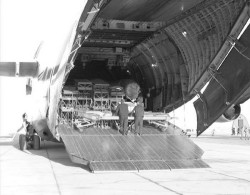
ThrustSSC arrives Al Jafr 6.30pm at the King Feisal Air Base in the HeavyLift Antonov 124. The aircraft carries 16 team members, the ThrustSSC on its trailer, the Jaguar XJ-R Firechase, the Pit Trailer, two Supacat tractor units, the Merlo all-terrain lifter, and the project's borrowed MAN tractor unit - loaned at the last minute by CRR in Feltham. Spares and support material include the project's two Spey 205 engines, tools, the Hughes satellite dish, the 60ft long Aireshelta inflatable hanger, and food for the 26 person team for 30 days. Temperatures are hot - 35 degrees C but despite the heat the Antonov unloading is completed by just past midnight. Considerable advance party work had been completed including the complete surveying of the 10 mile track and considerable defodding or stone removal. The winter's floods have left the track in pretty much the same condition as before - and the surface is very hard. There are still problems where the local Bedouin roads cross the Thrust track causing slight surface dips and work intensifies today to provide additional filling and compaction.
Established pit station on desert and moved all necessary equipment to site. Digital Internet Site together with its three web cameras is installed enabling Web Site visitors to see ThrustSSC inside the Aireshelta inflatable hangar, inside the Pit Station Control Centre, and an external view of the desert and the camp from the outside of the Pit Station. These pictures change every 15 minutes. First reports now on the Web Site with more pictures following tomorrow. Considerable work is continuing on the desert course including fodding, the marking of the white drive lines and groundwork to improve the desert surface. The track, orientated North-South (which conveniently avoids early morning or late evening glare from the sun) has three crossing points where local desert roads cross the desert. Local traffic is starting to wear grooves in the surface. Additional work is required to fill and compact these areas to avoid bumps which might cause ThrustSSC to fly. Additional roadmaking machinery has been rented from the Royal Jordanian Air Force to make good these grooves. Work started at 0700 am and is expected to be complete tonight.
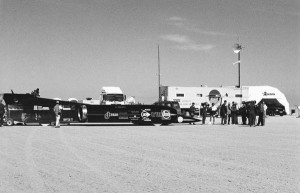
In the workshop, ThrustSSC is prepared for its first runs - the bodywork panels being secured and the nose mounted. The plan is to make two runs on the 26th at 120mph and 300mph - the objective being to first prove that the new steering, changes to suspension and the use of the twin keeled rear wheels work well - and then to run the car to 300mph thus reaching the same speed range as achieved last year. Also being proven for the first time is the use of the Pegasus Quantum Microlight spotting aircraft which is to be allowed to make safety flights only to check the desert perimeter for vehicle and camel movements and also spot during the ThrustSSC runs. The Quantum is flown by World Champion Simon Baker. Much work continues to clear and prepare the tracks, despite the searing heat.
Today, a hard day's work was put in by the team and the Royal Jordanian Air Force in preparing the track for this week's runs. The work was not quite completed due to a serviceability problem with the grader - but it is hoped to complete the major earthworks today. The white lining is currently ahead of plan but further work is delayed due to problems with the pickup truck. There are now 36 miles of 50ft wide lane ready for use. After all the course markings, the team is now one of the major users of Ghia, a white local paint more normally used on the outside of buildings to help protect them from the heat.
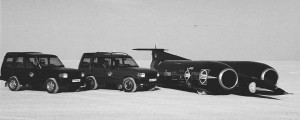
ThrustSSC makes its first 136mph run to test systems after the flight from UK. The run target speed was 120mph with a brief use of military power selected at 80mph. Driver Andy Green reports that the steering response is generally good and far better than in 1996. The steering felt less precise than when the car was on rubber tyres operating on the Farnborough runway which was to be expected. Suspension ride was also better than in 1996 and the run generated great confidence. Subsequent analysis of the video and data records shows a possible recurrence of the vibration/oscillation problem on the rear steering wheels. It was seen that the rear wheels gave a slight kick when the car hit raised dust patches on the course. The ThrustSSC rear wheel steering system is investigated in great detail and it is decided that there is no evidence of the 1996 shimmy and that the steering system is intact. The effect seen is possibly being magnified by camera position and angle. To deal with the small steering deflections caused by the dust patches, Spax steering dampers are refitted and the plan is to run again tomorrow at the same speed over the same track so that evidence can be compared.
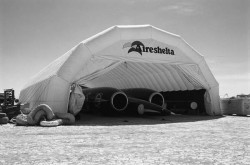
Although the car is now ready to run, the team has to take an enforced day off because of activity by the Jordanian military on the desert. Since this activity is testing surface to air missiles, then this is probably a wise move! Further time is spent making final checks to both the car and all the equipment necessary to start it and turn it around.
03:30 Jordan time - woken up by a John Lee Hooker CD instead of the usual chanting from the mosque! Half way through the night so it must be a run day. Quick breakfast at 4am and then straight onto the desert to prepare the car. At 5am the desert is nice and cool with no breeze. This soon changes though. First job is to download the overnight temperature readings and produce a graph of falls and rises. 16 degrees C at 5am - not bad. The car should appreciate the cool run. Prepare equipment for 100mph, steering damper proving run. Hope all goes well.
06:00 All equipment ready, just waiting for SSC's cameras to be set up. Go out to the tracks with Andy Green to replace the Fetchers dislodged by the storm the previous afternoon. Found an interesting object at mile 6.4 100 yards from track 12. Unfortunately, unable to identify what it was at the time. Went to the proposed start point (mile 6.0, track 12). We are concerned about the state of the surface in this area and its use as a start point due to the storm previously mentioned. Andy and I inspect the start area and decide to move 200 yards south (mile 6.1) to clear the loose surface. On return to the pit station, the car is outside almost ready to tow. The car looks a million dollars in the early sun.
08:30 Uneventful tow out to mile 6.1 heading south. Prepare for the engine start and the run itself. Everything goes well and by 09:20 or thereabouts, Andy's under way. Brilliant!
09:30 Start. Pack kit away and return to the pit station trailer for a design team meeting to analyse data and videos from that run. It's only 10:00 and the temperature is up to 22 degrees C in the shade. Analysis of the data is good - dampers appear to be working as advertised. But with a beast this complicated, it does throw another curved ball - the 24v supply is lost and Andy lost some of the systems. Jerry and the team can fix it, but not in time for another run today - the temperature beats us again. SSC returns to shelter, all have a welcome break and de-brief.
12:00 - Correlate the morning's temperature graph. Look at the engine data from the on board boxes - all well in the engine department. They seem to be coping well with these temperatures. No burner selections as yet though! Break for lunch - peanut butter sarnies, plus cold coke - great! Brief siesta.
14:30 Start to reassemble the V8 LandRover (heads off, gasket gone). Spares arrive from the UK - gasket set courtesy of our pipeline (basically anyone who hints that they are coming out gets loaded up with the items we find we need). Seem to have inherited all the mechanical work on the poor old Landy. Still, you don't get on this team if you can only turn your hand to one thing - about 1000 is the minimum, and at least half of those you must be able to carry out simultaneously!
17:00 Knock off with about 2 hours of work left on 'Landy One'. Must go to attend the design team meeting to plan tomorrow's runs - yes runs, we are going to do 2 tomorrow, so that's another 03:30 start!
18:30 Straight into dinner, another team meeting followed by a welcome sit down, shower and then bed!! Another long, hot day, but a good one - anybody whoever said that record breaking was easy needs their head testing!!!
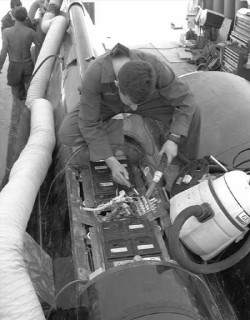
On roll-out , ThrustSSC develops an hydraulic leak and problems with the second on-board computer used to retain run data. At first it was thought that the computer problem is due to the very high temperatures being developed in the computer bay (105 degrees C) as a consequence of late running during the early morning - this could have resulted in the need for a computer rebuild in the UK and a three day delay. In fact the problem is traced to a faulty switch. The hydraulic system problem related to air in the system - the delays meant that the car could not complete its runs by 10.20am so the opportunity is taken to change the hydraulic pump. The car is prepared ready for an immediate roll-out on May 30 first light tomorrow morning for the 200 and 320mph run profiles.
ThrustSSC makes two medium speed runs in the crucial early morning period after dawn before the temperature exceeded 25°C. Team operational on site at 5.00am, with ThrustSSC rolled out before 0600.
The first run is a 208mph proving run using military power and is quickly accomplished. The second run soon follows after checking of output from the 5 onboard video cameras and data readout from some of the 147 data channels on the car. Andy Green carries out the run with extreme precision reaching 301mph. The design team are now confident of car and driver and have decided to proceed quickly to the next stage - 350mph with minimum afterburner and then a second run at 400mph.
Also moving up to its 1m access/week target is the ThrustSSC Digital Internet Web Site where the access rate is growing at 50%/day. Estimated hits for today are 70,000.
For the fourth day running, the ThrustSSC team are out on the desert at first light. Today they have high expectations that their car will make its fastest run to date, exceeding the 331mph achieved last November. On the first run, Andy drives exactly to plan and records a peak speed of 379mph. The turn-round team check and prepare the car for its second run, while the design team examine the telemetry and video. All's well, and the go ahead is given for a faster run. Andy again drives exactly to plan and this time achieves a peak speed of 410mph. Again, all is well apart from visual and video evidence showing the parachute weaving around as the car slowed. "There is a relatively simple fix", Richard Noble tells the world via the press and Internet information releases. In fact, what he doesn't tell them is that the simple fix is just to make the hole in the centre of the parachute bigger!
Engineering day. New SPAX dampers, just arrived from the UK will be fitted to the steering during the service period. Always planned as a long term application, this will enable the car to control 'bump steer' as it progresses upwards through the speed range. Work will continue into Monday 2nd June.
More engineering today, including engine servicing - Detailed inspection of the engines is essential after each run day to maintain high efficiency and reliability. Chris Cowell and Steve Wiltshire religiously check oil levels, air compressors, magnetic bearing monitors, panels for fluid leaks and rear of engines for jet pipe cracks or damage from stones. A general clean up is of course done as a matter of routine.
Parachutes - Design adjustments are also carried out to the parachutes. Hopefully, these will increase stability, following a slight oscillation discovered at the higher speeds now being achieved by ThrustSSC.
Track Preparation - Mike Hearn makes dramatic progress with support from a great team effort of "fodders", preparing 13 miles of track in one day in the searing heat.
ThrustSSC runs in the early morning reaching a peak speed of approximately 462mph. The track used for this run is more uneven that previously encountered. The car's suspension coped exceptionally well, however the pitot tube airspeed sensor worked loose during the run and therefore the design team could not confirm the speed accurately. Because the pitot tube could not be re-bonded before the temperature rose above the team's self-imposed limits, the second run had to be postponed. The plan is to repeat the run profiles of 460 and 530 mph ground speed at first light Wednesday 4th June.
ThrustSSC's first run of the day was completed successfully and the peak speed confirmed at 479mph. The rebonded pitot tube air speed sensor performed well and gave accurate correlation with the speed measured by the wheels. Authorisation was quickly given by the Design Team to proceed with next run as planned. Second run was completed and a peak speed of 540mph exactly as planned. Andy again reported minor steering difficulty as the car sped across the hard, uneven surface of the Al Jafr desert. Despite this, the car was brought safely to a halt with minimal deviation from the planned course. Following inspection reveals that during the second run, a bracket had failed and limited damage had occurred to the rear suspension. This was the cause of Andy's concern noted during the run. Failsafe design resulted in ThrustSSC being recovered safely from 540 mph (See Engineering Report for full details).
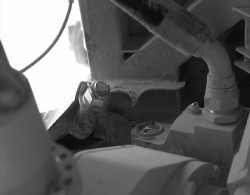
The team meeting that evening started off very downbeat. The damaged rear suspension had been evaluated during the day, and the estimate was that repairs would take about two weeks to complete. With every day getting that little bit hotter, working conditions in Jordan were getting more difficult. The team really had no option and took a unanimous decision to return home to tackle the modifications. However, the despondency didn't last long when the team took stock of the situation and looked back over the last 13 days. They soon realised what they had achieved and began to celebrate their considerable successes - and after all, at 540mph, ThrustSSC was now one of the fastest cars ever built! At the end of the meeting, Richard Noble said to the team, "there are still tough times ahead, do we carry on, or does anyone feel like quitting?" Again the team were unanimous - not one of the team had any intention of giving up now, and from that moment on, everyone set their sights firmly on Black Rock with renewed vigour. The supersonic record is ready to be taken!
The following few days were spent at a rather less hectic pace - after 13 very full and busy days, everyone was relieved that the pressure was off. On Thursday 4th June, after a day spent packing at the desert pit station base, the team enjoyed a memorable evening barbecue - right in the middle of the Al Jafr desert! All the equipment was taken back to the Al Jafr airbase by the evening of Friday 5th June, and the desert returned to normal. Several team members who had used up much of their annual leave left for England almost immediately. More followed a few days later. Others took time off and enjoyed what the local area had to offer - some went to Aqaba, some to Israel and Egypt, those who missed visiting Petra last year made up for it now.
ThrustSSC, all the equipment and the remaining team members returned to England in the HeavyLift Antonov on Saturday 21st June.


 |
 |
 |
||
| Sponsored by | This site best viewed with Microsoft Internet Explorer 3 | |||